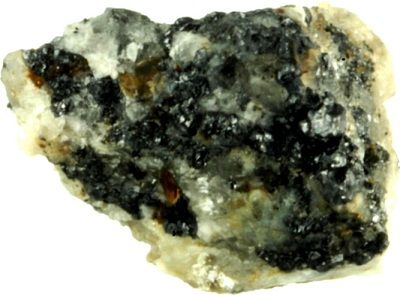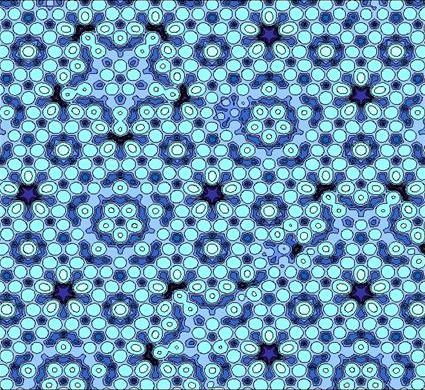(A regular snowflake is shown to have 6-fold rotational symmetry.)
This makes sense when you use pictures: for instance, try to cover an entire area with pentagons attached to each other, and you will indeed fail:
However, this theorem-- as well as the basis of crystallography itself-- has been corrected in 1984 with the revolutionary works of Dan Shechtman and his synthesis of aluminum-manganese alloys with icosahedral symmetry.
(A icosahedron has twenty equilateral triangles as its faces.)
This figure is especially troubling to believers of the original CRT, as it has numerous 5-fold symmetric axes. One such axis is shown below:
These crystals, due to their unusual symmetries, have been called quasiperiodical crystals, or in short quasicrystals. Because of their unusual characteristics--especially that of rotational symmetry-- its existence has been doubted by many scientists.
So how can such molecules be made, with the proven CRT still standing? Well, if we look at the second picture of this blog (the one with pentagons), we see that the gaps between the pentagons become the problem; however, in quasicrystals the gaps are filled with differently shaped atoms, while rotational symmetry is still maintained.
As Marjorie Senechal, a specialist in mathematical crystallography, describes it, such symmetries are forbidden. And such criticisms are what Mr. Shechtman and his team faced initially, when they published their highly-controversial results.
As Marjorie Senechal, a specialist in mathematical crystallography, describes it, such symmetries are forbidden. And such criticisms are what Mr. Shechtman and his team faced initially, when they published their highly-controversial results.
(image of Al6Mn)
Even after such criticisms were resolved, numerous scientists refused to believe in the entire concept; they continued to argue that these crystals, nonetheless, could only be formed synthetically (i.e. it cannot be naturally found). This belief was again proven false with the discovery of icosahedrite (Al63Cu24Fe13), the first natural quasicrystal found. This solid also has an icosahedral symmetry.
With the naked eye, it does not appear to be so special:
Yet on a microscopic level, this quasicrystal exhibits 5-fold symmetries-- a fact which surprises scientists even to this day. Its diffraction patterns, or patterns created when beams of X-rays strike a solid and spread into directions provided by the solid's edges, are shown below:
(Pattern (a) shows a 5-fold rotational symmetry, while (b) shows a 3-fold symmetry.)
Thus, since its appearance in the field of crystallography three decades ago, these quasicrystals have been studied vigorously by scientists around the globe. Hundreds of other quasicrystals, with 5-fold, 8-fold, 10-fold, 12-fold and 15-fold symmetries, have also been created.
(One such example is the aluminum-palladium-manganese quasicrystal; its atomic model is shown here. It exhibits 5-fold rotational symmetries but no translational symmetry.)
Paul Steinhardt, professor of physics at Princeton University, summarizes the effect of the emergence of quasicrystals as following:
This new subject is undoubtedly revolutionizing the field of crystallography. Thomas Kuhn, a prominent physicist and philosopher of science, would have gladly called it the bringer of a paradigm shift.The 30-year history of quasicrystals is one in which, time after time, the conventional scientific view about what is possible has been proven wrong.








No comments:
Post a Comment